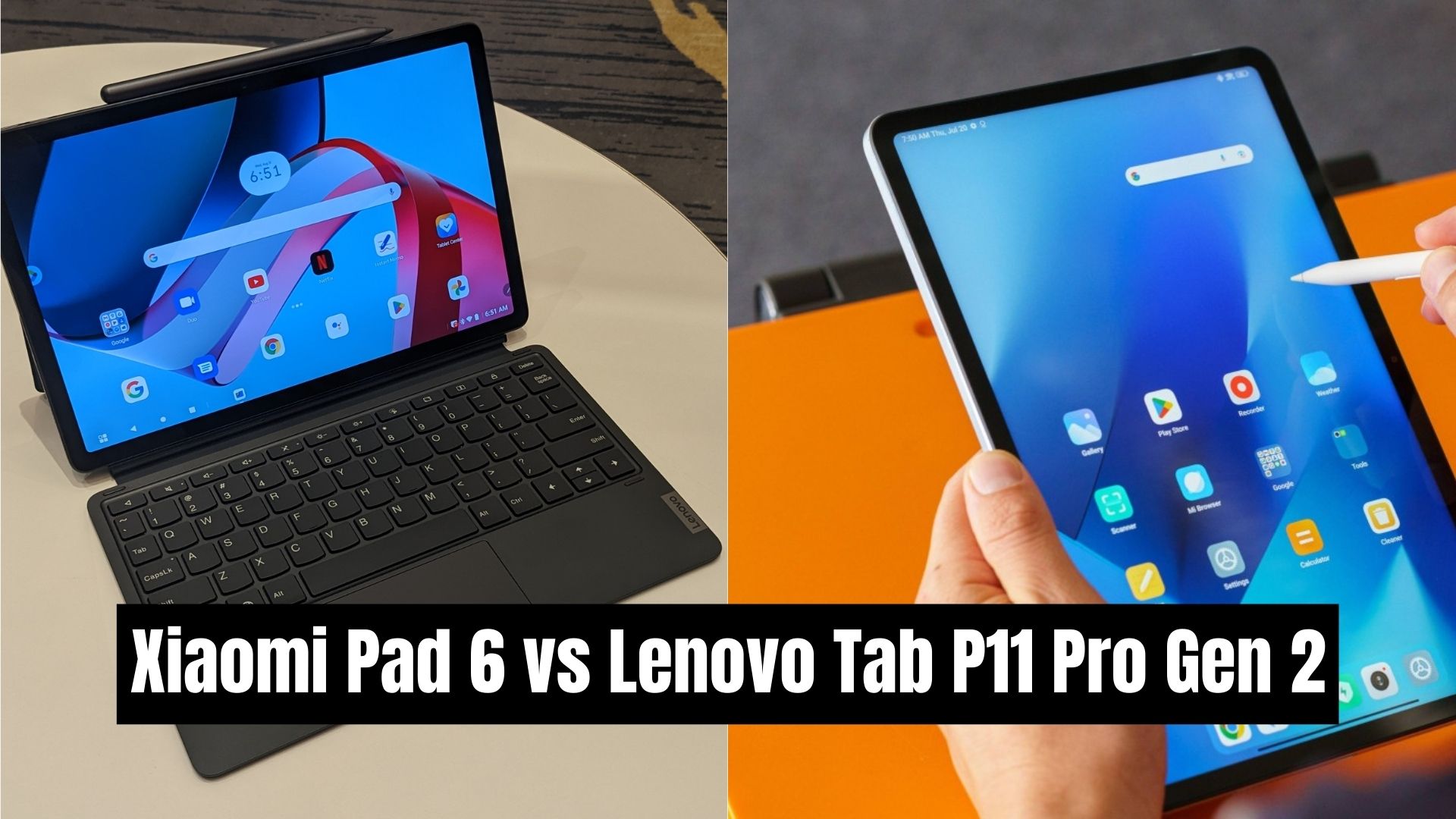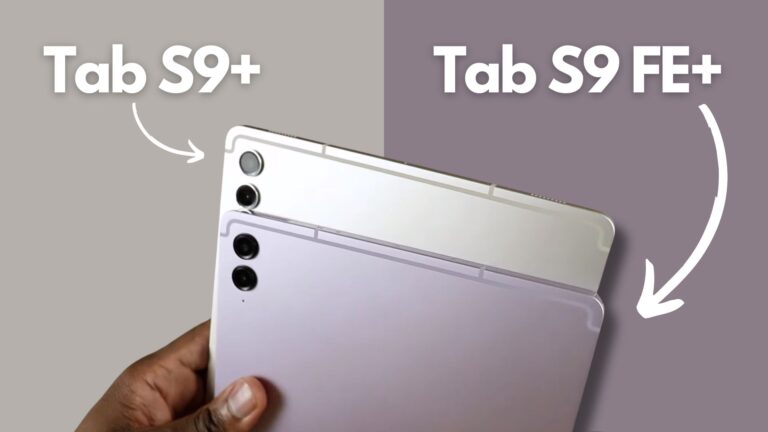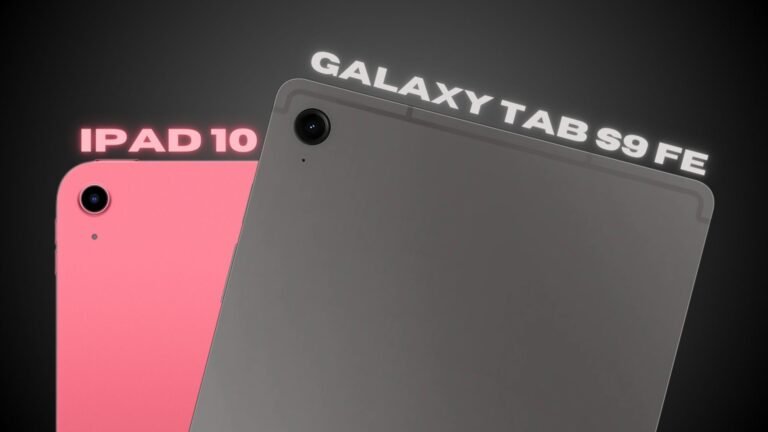Today, I have an interesting comparison. I’m curious about how the new Xiaomi Pad 6 stacks up against one of the newest Lenovo Tab P11 Pro. In this post, I will compare them as much as possible to find out which one is better.
Price & Storage
| RAM | 6GB / 8GB LPDDR5 | 4GB / 6GB / 8GB RAM |
| Storage | 128GB / 256GB UFS 3.1 | 128GB / 256GB, expandable up to 1TB |
Pricing for the P11 Pro starts around $400, but you can currently get it for as low as $300. The Xiaomi Pad 6, on the other hand, is priced around $400.
Storage-wise, both come with 128GB or 256GB. The Xiaomi Pad 6 offers 6GB or 8GB of RAM, while the P11 Pro offers 4GB, 6GB or 8GB of RAM.
One advantage for the P11 Pro is the option to use a Micro SD card for expanded storage. However, keep in mind that not all apps will save to the SD card, but for photos, videos, and other files, it should be fine.
Display Difference
| Display | 11-inch (2880 x 1800) | 11.5-inch (2560 x 1536) |
| Resolution | 16:10 | 2.5K OLED |
| Refresh Rate | 30/48/50/60/90/120/144Hz | 120Hz |
| Touch Sampling Rate | 240Hz | 10-point multitouch |
| HDR Support | HDR 10, Dolby Vision | Dolby Vision, HDR 10+ |
Both tablets boast quality displays but differ slightly. The P11 Pro features an 11.2-inch OLED display with a resolution of 1536 by 2560, while the Xiaomi Pad 6 has an 11-inch IPS LCD display with a resolution of 1800 by 2880.
The colors on the P11 Pro seem a bit more vibrant and have better viewing angles. However, the Xiaomi Pad 6 appears more natural. The P11 Pro also boasts a 120Hz refresh rate, while the Xiaomi Pad 6 offers up to 144Hz. Both tablets support upscaled 4K resolution on YouTube and Full HD playback on apps like Netflix.
Software & Performance
| Processor | Snapdragon 870 7nm | MediaTek Kompanio 1300T |
| GPU | Adreno 650 | ARM G77 MC9 836 MHz |
| Operating System | Android 13 with MIUI 14 for tablets | Android 12 |
Software-wise, the P11 Pro Gen 2 runs on Android 12, while the Xiaomi Pad 6 is on Android 13. Both tablets have their unique features.
The P11 Pro offers the Google entertainment space to the left of the home screen, while the Xiaomi Pad 6 features Google Discover. The notification shade on the Xiaomi Pad is split into two parts, reminiscent of the iPad’s design, whereas the P11 Pro has a more traditional all-in-one style.
It also offers a productivity mode, similar to Samsung Dex. For those interested in stylus functionality, the P11 can be paired with the Precision Pen 2 or 3, while the Xiaomi Pad 6 works with the new Smart Pen 2nd generation.
Performance-wise, both tablets are closely matched. The P11 Pro is powered by the MediaTek Companion 1300T processor, while the Xiaomi Pad 6 boasts a Snapdragon 870.
I tested come with 6GB of RAM. Gaming performance is fairly consistent between the two, with both handling games like PUBG Mobile and Asphalt 9 smoothly.
Camera & Audio
| Rear Camera | 13MP, f/2.2 aperture, PDAF | 13MP, f/2.4 aperture, LED flash |
| Front Camera | 8MP, 105° FoV, focus frame | 8MP, 83° FoV |
| Audio | USB Type-C audio, Dolby Atmos | Quad JBL Speakers (sound by JBL), Dolby Atmos |
The Xiaomi Pad 6 is equipped with a 13MP primary camera featuring an f/2.2 aperture and PDAF, ensuring crisp and clear photos. Its front camera, with an 8MP sensor, boasts a 105° FoV and a focusing frame, making it perfect for expansive selfies and video chats.
On the other hand, the Lenovo Tab P11 Pro Gen 2 features a 13MP main camera with an f/2.4 aperture complemented by an LED flash, ensuring quality shots in varied lighting. Its 8MP front camera, with an 83° FoV, is designed for selfies and video interactions.
While both tablets offer commendable camera capabilities, the Xiaomi Pad 6 edges out with its broader 105° FoV on the front camera, facilitating more inclusive selfies and enhanced video conferencing.
Neither tablet offers a headphone jack, but both feature two speakers on each side with Dolby Atmos support.
Battery & Charging
| Battery | 8840mAh (typical)/8640mAh (min) | 8200mAh (typ.) / 8000mAh (min.) |
| Charging | 33W Fast charging | 20W Normal Charging |
Battery performance is quite close between the two. The P11 Pro lasted about 7.5 hours, while the Xiaomi Pad 6 lasted about 7 hours in tests conducted at 100% screen brightness. In terms of charging, the Xiaomi Pad 6 supports 33W fast charging, whereas the P11 Pro offers a slower 20W charging.
Final Thoughts
The Xiaomi Pad 6 and Lenovo Tab P11 Pro Gen 2 both stand out with their unique features and specs. The Xiaomi Pad 6 boasts an adjustable refresh rate display, a robust Snapdragon 870 chipset, and a front-facing camera with a wide 105° field of view. On the other hand, the Lenovo Tab P11 Pro Gen 2 shines with its OLED screen, and an elegant design.
Your choice between these two tablets will hinge on your personal needs and preferences. If a dynamic refresh rate and a potent processor are at the top of your list, the Xiaomi Pad 6 may be your go-to. Conversely, if you’re drawn to an OLED screen and a more refined, lightweight design, the Lenovo Tab P11 Pro Gen 2 might be more up your alley.
For a well-rounded decision, consider your specific needs, like your display preferences, the device’s power, and how often you’ll be using the camera.








